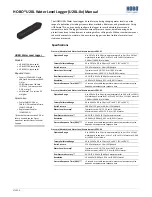
HOBO U20L Water Level Logger (U20L-0x) Manual
1-800-LOGGERS 7
www.onsetcomp.com
Maintenance
The logger requires the following periodic maintenance to
ensure optimal operation:
•
Protect the logger. This logger can be damaged by shock.
Always handle the logger with care. The logger may lose its
calibrated accuracy or be damaged if it is dropped. Use
proper packaging when transporting or shipping the logger.
Important:
Do not attempt to open the logger housing!
Unscrewing the nose cone of the logger will cause serious
damage to the pressure sensor and logger electronics.
There are no user serviceable parts inside the case.
Contact Onset Technical Support if your logger requires
servicing.
•
Periodically inspect the logger for biofouling
. Biological
growth on the face of the pressure sensor will throw off the
pressure sensor’s accuracy. Organisms that grow inside the
sensor nose cone and on the sensor itself can interfere with
the sensor’s operation and eventually make the sensor
unusable. If the deployment area is prone to biofouling,
check the logger periodically for marine growth.
•
Be careful of solvents.
Check a materials-compatibility
chart against the wetted materials listed in the
Specifications table before deploying the logger in
locations where untested solvents are present. The logger
has Viton and Buna-N O-rings, which are sensitive to polar
solvents (acetone, ketone), ammonia, chlorine, and brake
fluids. The sensor is housed in an acetal end cap. Acetal is
resistant to most solvents, fuels, and lubricants. The black
polypropylene cap is provided to help protect the
communications window. The polypropylene
communications window is sealed as an additional barrier
to prevent water and dirt from entering the logger
housing.
Compensating for Drift
All pressure sensors drift over time. The drift for the pressure
sensor and electronics in the HOBO U20L Water Level logger is
less than 0.5% FS (worst case) per year. In most applications,
drift is not a significant source of error, because the offset
created by any drift is zeroed out when you take a manual
reference level measurement and use the logger software to
automatically calculate the level readings relative to the
reference measurement. In effect, you are re-zeroing the
sensor each time you apply a reference reading to the data file.
Pressure sensor drift matters only when absolute pressure
values are needed, or if there are no recent reference level or
depth measurements available. For example, if the logger is
deployed for one year and no new reference level readings are
taken during the deployment, it is possible that the sensor
could have drifted as much as 0.5% FS by the end of the
deployment.
It is possible to determine the actual amount of drift during a
deployment if a reference level is taken at the beginning and
the end of a long-term deployment. The results of applying the
two different reference levels (once at the beginning of the
data file, and again at the end of the data file) can be
compared. Any difference between the files indicates the
amount of sensor drift (assuming accurate reference levels).
Verifying Accuracy
You can check the
differential accuracy
of your loggers for
water level measurements by deploying the loggers at two
depths and comparing the difference in level readings. When
verifying the accuracy this way, be sure to allow the loggers’
temperature to stabilize at each depth. Use the logger software
to convert the readings from pressure to level. The level
readings should be taken close enough together that the
barometric pressure does not change.
You can check the
absolute pressure accuracy
of your HOBO
U20L Water Level Logger by comparing its ambient pressure
readings to a second HOBO logger. Their readings should be
within each other’s specified accuracy. Alternatively, you can
check the pressure reading against an accurate local
barometer. If you use a non-local source of barometric
information, such as the NOAA website, adjust for altitude.
Battery Guidelines
The battery in the HOBO U20L Water Level Logger is a 3.6 Volt
lithium battery.
•
Battery Life.
The battery life of the logger should be about
five years or more. Actual battery life is a function of the
number of deployments, logging interval, and
operation/storage temperature of the logger. Frequent
deployments with logging intervals of less than one
minute, and continuous storage/operation at
temperatures above 35°C will result in significantly lower
battery life. For example, continuous logging at a one-
second logging interval will result in a battery life of
approximately one month.
To obtain a five-year battery life, a logging interval of one
minute or greater should be used and the logger should be
operated and stored at temperatures between 0° and 25°C
(32° and 77°F).
•
Battery Voltage. The logger can report and log its battery
voltage. If the battery falls below 3.1 V, the logger will
record a “bad battery” event in the datafile. If the datafile
contains “bad battery” events, or if logged battery voltage
repeatedly falls below 3.3 V, the battery is failing and the
logger should be returned to Onset for battery
replacement.
•
Replace the Battery. To have your logger’s battery
replaced, contact Onset or your place of purchase for
return arrangements. Do not attempt to replace the
battery yourself. Severe damage to the logger will result if
the case is opened without special tools, and the warranty
will be voided.


























